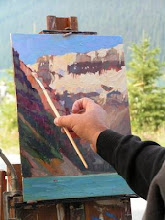 I chose the title "Painting Haystacks" since it does describe the approach of my work. I'm referring to Claude Monet's repetitious, and what appears, duplications of haystacks and other motifs.
I chose the title "Painting Haystacks" since it does describe the approach of my work. I'm referring to Claude Monet's repetitious, and what appears, duplications of haystacks and other motifs.To understand this, the artist is NOT duplicating paintings but, instead, exploring color , texture, and all of the complexities that confronts him or her in the process of creating art.
Recently confronted by an artist, I was asked if I got tired of painting tulip fields. I had to smile at this question because, this artist wasn't that familiar with my work. Yes, the migrant workers and the tulip fields of this Skagit Valley region of Washington State do contribute about 30%-40% of my work but, I also paint other motifs as well. As a business decision, I tend to send these works to galleries outside this region.

In the small study of "Alla", I was exploring the migrant farm workers from a pencil sketch. The oil study allowed me to work out the invented figures. For the final painting "Unison", I used the figures as a center compositional tool so the eye of the viewer did not go directly to the sun. The idea here was to stop the viewer so he or she would explore the painting. Now, all that I said in this paragraph are learned techniques that I've acquired over the years of working at my "craft".
 But, Fine Art is my goal here, not craft. This is what binds "Unison" and "Snow Valley" together. These two paintings, although a similar subject matter of past paintings, are not duplications. These paintings are the exploration of color and texture. To be specific, an exploration of the saturation of color provided by intense sunlight. Within each value range of color, I have broken the color down in triads of color application.
But, Fine Art is my goal here, not craft. This is what binds "Unison" and "Snow Valley" together. These two paintings, although a similar subject matter of past paintings, are not duplications. These paintings are the exploration of color and texture. To be specific, an exploration of the saturation of color provided by intense sunlight. Within each value range of color, I have broken the color down in triads of color application.With the music playing, I dance with my brush and palette knife, lost in the process of painting and seldom acknowledging my subject matter.






